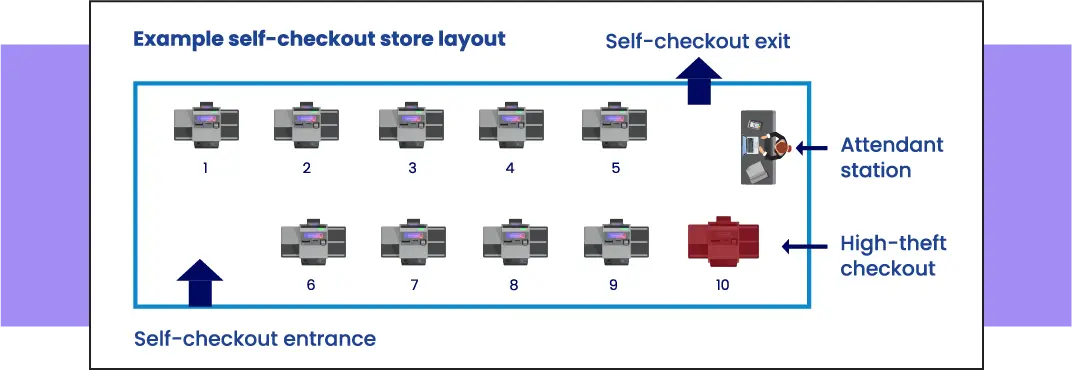Artificial Intelligence (AI) in Grocery Stores Self Checkout
03rd April 2024

Artificial intelligence (AI) in Grocery Stores – Uncovering shrink at the self-checkout
SeeChange was recently invited by a European grocery retailer to help identify where at self-checkout shrink was happening. The retailer believed they understood the ‘when’ and ‘how’, and expected the results to show that barcode switching was the main theft method at self-checkout. However, solutions that deliver real ROI address the true pain points, not just test assumptions. We set out to demonstrate the when and how, and also pinpoint the where, why and revenue impact of each shrink type. We put AI to work, and what we learned may surprise you.
Discover how SeeChange and Diebold Nixdorf are transforming the retail checkout
Shrink is hitting the retail industry hard. In the US, shrink represented $112 billion in losses in 2023, with 65% of that attributed to internal and external theft. In the UK cost of shrink has doubled year over year to $2.3BN in 2023. And nowhere is shrink being felt more than in grocery retail.
Grocery operates on notoriously tight margins, yet worsening shrink KPIs and opaque insights make getting to the root causes of shrink and then addressing them challenging. Historically, retailers have factored in between 1% and 1.5% for shrink, yet for many that figure has grown quickly with some now experiencing over 3.5% and the situation showing no signs of slowing.
With rising costs on one hand and reduced consumer spending power on the other, the only impactful opportunity to improve the landscape is to reduce shrink.
Proximity matters – self-checkout layout vulnerability revealed by AI
It may seem counter-intuitive, but a key finding for this retailer was that the self-checkout closest to the attendant station had the highest rate of shrink. The cause? The attendant is always on their feet and helping customers at the individual self-checkout, which means the attendant station is rarely manned.

Logically, self-checkouts placed in potential blind spots for the attendants do create opportunities for shrink that determined shoplifters will capitalise on. Examples include:
- Shoppers not scanning items, instead putting items into pockets or bags at their feet, bypassing the weigh scales entirely
- Barcode switching on expensive products enabled by fruit and veg weigh scales in aisles
- Walking away from transactions with the goods without paying
To a busy attendant it will look as though transactions are progressing normally, when in fact the opposite is true.
In fact, contrary to the assumption that barcode switching was the most prominent cause of self-checkout theft for this retailer, it was revealed that intentionally not scanning items (an effective buy-one-get-one-free) caused the most significant shrink. This means that even when armed with information from store leadership, attendants could be looking for the wrong thing entirely when trying to meet loss prevention expectations.
How is AI used in supermarkets?
Embedding real-time retail artificial intelligence shrink solutions in grocery self-checkouts allows for immediate detection, and customised responses to accidental and intentional theft attempts. Equipping attendants with AI-enhanced mobile devices gives real-time oversight of the self-checkout area, with the ability to prioritise interventions and assistance, and enable safe escalation where needed without disrupting customers while ensuring the safety of both employees and shoppers.
The store closure routine causing a shrink surge
One of the significant peak shrink trends identified was during the final two-hour window before store closing. Which begs the question; what was different for this retailer during that final two hours to cause an over three percent increase in shrink?
During the final hours of trading, staff efforts were partly diverted to store clean-up and restock, drawing employees away from the checkout areas and driving them into the heart of the store to contribute to the next day’s preparation efforts. This redeployment of employees to other activities inadvertently created a window of opportunity that was exploited daily.
Artificial intelligence delivers deep insights, far beyond the initial hypothesis, and crucially offers retailers the ability to continuously learn and recognise new, subtle loopholes to exploit systems that are missed by human observation. This means gaining insights to both recognise and get ahead of emerging behaviour.

From frustration to shrink – how self-checkout delays lead to losses
In peak times, with one attendant covering more than eight self-checkouts in a chaotic environment, the AI in store identified situations in which weigh scales or other self-checkout blockers caused significant delays to customer transactions, which causes frustration particularly when employee assistance takes time to arrive.
For example, a customer may mis-scan an item. When the item touches the security scales, the system creates an alert, and the self-checkout is blocked.
The time it takes for an attendant to reach the customer, particularly in peak times, can be longer than a customer is willing to wait. In 5% of the observed scenarios, given enough time with a blocked self-checkout, frustrated customers simply walked away with their goods.
The use of nudges or hints on screen at self-checkout in 80% of cases leads to the customer self-correcting mistakes, reducing self-checkout theft significantly without requiring employee intervention. By recognising any attempt, intentional or otherwise, to defraud the system, and presenting this back to the customer this retailer could immediately begin to recover 1.8% of losses – over 50% of total shrink from self-checkout alone.
What is the future of AI in retail?
The findings from this project underscore the importance of challenging assumptions and the value of leveraging the power of AI in grocery stores to gain deeper insights into shrink patterns. By utilising AI self-checkout solutions retailers can:
- Identify hidden vulnerabilities – Gaining a deep insight into previously unknown factors contributing to shrink.
- Spot emerging trends – detect changes in customer behaviour or operational practices that may lead to losses.
- Improve customer experience – reduce friction at self-checkout and minimise interventions
In all cases, ensure you are able to target AI so it meets your specific needs. Retailers need to be able to control the level of automation and intervention, tailoring solutions to their risk tolerance and business goals. For example, what is more important at 5pm on a Friday – throughput or stop and deter?
AI sees beyond the assumptions
Traditional approaches to shrink management are no longer sufficient. By embracing and operationalising AI in grocery stores, retailers stand to benefit from deep understanding of exposure points and implement targeted solutions to recover lost revenue, while also enhancing overall security and customer experience.


